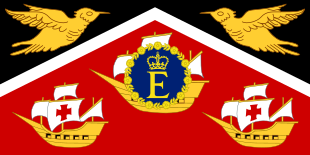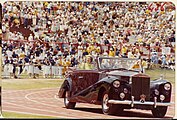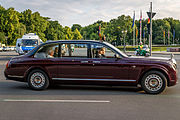Flags of Elizabeth II
This article possibly contains original research. (February 2021) |

Queen Elizabeth II has and has had a variety of flags to represent her personally and as head of state of 16 independent nations around the world. They are usually used on any building, ship, car, or aircraft where she is present.
These heraldic flags are usually a nation's coat of arms in banner form.
As Princess Elizabeth[]
Princess Elizabeth's personal standard prior to her accession as queen was her coat of arms in banner form. This consisted of four quarters consisting of three lions passant for England, a lion rampant for Scotland, and a Gaelic harp for Ireland. To differentiate the arms of Princess Elizabeth from that of the King it was differenced with a white label of three points, the centre point bearing a Tudor rose and the first and third a cross of St George.

1944–1952

Scottish version
As Sovereign[]
United Kingdom[]
Upon the death of her father, Princess Elizabeth became Queen Elizabeth II and therefore adopted the Royal Standard. This flag is used to represent the Queen not only in the United Kingdom but also overseas when she makes state visits. It is the royal arms in banner form undifferentiated.

Outside Scotland

Scotland
Other Commonwealth realms[]
Since the 1960s, flags have been introduced to represent the Queen in various Commonwealth realms. These flags have followed the same basic pattern: the nation's coat of arms in banner form with the device found on her personal flag. These flags are only used by the Queen when she is in their respective countries. The Queen's representatives in these nations have their own flags to represent them.
Sierra Leone[]

The Queen's Sierra Leonean standard was created time when she visited the Sierra Leone in 1961, in her capacity as Queen of Sierra Leone.[1][2][3] The flag featured the coat of arms of Sierra Leone in banner form, which depicts a lion beneath a zigzag border, representing the Lion Mountains, after which the country was named. It also shows three torches which are meant to symbolize peace and dignity. At the base are wavy bars depicting the sea. A blue disc of the letter "E" crowned surrounded by a garland of gold roses defaces the flag, which is taken from the Queen's Personal Flag.[4][5] The Sierra Leonean standard also served as the inspiration for the design and layout of her personal standard for Canada.[6]
Canada[]

he Queen has a personal Canadian Flag in her role as Queen of Canada. The flag was adopted and proclaimed by her on 15 August 1962.[7][8] The flag, in a 1∶2 proportion, consists of the escutcheon of the Royal Coat of Arms of Canada in banner form defaced with the distinct device of Queen Elizabeth II:[9] a blue roundel with the initial E surmounted by St Edward's Crown and within a wreath of roses, all gold-coloured.[8] The standard is protected under the Trade-marks Act; section 9(a) states: "No person shall adopt in connection with a business, as a trade-mark or otherwise, any mark consisting of, or so nearly resembling as to be likely to be mistaken for... the Royal Arms, Crest or Standard."[10]
Australia[]

The Queen has a personal Australian Flag in her role as Queen of Australia. The flag was approved for use in by the Queen on 20 September 1962. The flag consists of a banner of the coat of arms of Australia, defaced with a gold seven-pointed federation star with a blue disc containing the letter E below a crown, surrounded by a garland of golden roses.[11] Each of the six sections of the flag represents the heraldic badge of the Australian states, and the whole is surrounded by an ermine border representing the federation of the states:[12]
New Zealand[]

The Queen has a personal flag in her role as Queen of New Zealand. It was approved for use in 1962. It is flown only by the Queen when in New Zealand. The only time the flag is flown in the absence of the Queen is at parades held on and in honour of her official birthday.[13] The flag is the escutcheon of the arms of New Zealand in banner form, defaced with a blue roundel surrounded by a garland of roses encircling a crowned letter 'E', all in gold.[14]
The flag is divided into four quadrants: The first quadrant includes depicts four stars as representative of the Southern Cross constellation, as depicted on the national flag. The second quadrant consists of a golden fleece on a red field. The third quadrant contains a golden wheat sheaf on a red field. The final quadrant includes two crossed gold hammers on a blue field. The central stripe consists of three ships. Superimposed in the centre is a dark blue roundel bearing a Roman E surmounted by a Royal Crown within a chaplet of roses, all gold-coloured, obscuring the centre ship.
Trinidad and Tobago[]

The Queen's personal flag for Trinidad and Tobago was used for the first time when she visited the Trinidad and Tobago in 1966. The flag consisted of the Coat of arms of Trinidad and Tobago in banner form defaced by a blue disc of the letter "E" crowned surrounded by a garland of gold roses, taken from the Queen's Personal Flag.[2][15][16][17]
Jamaica[]

The Queen has a personal flag in her role as Queen of Jamaica. It was first used when she visited Jamaica in 1966, as part of her Caribbean tour.[17] The flag consists of a banner of the coat of arms of Jamaica defaced with the Queen's Royal Cypher. The flag is white and bears a red St George's Cross. A gold pineapple is superimposed on each arm of the Cross. A blue disc with the Royal Cypher is placed in the centre of the Cross. The disc is taken from the Queen's Personal Flag.[18]
Malta[]

The Queen had a personal flag for use in Malta, in her role as Queen of Malta.[19] The flag was first used by the Queen when she was in Malta in 1967. The Queen's flag consisted of the Coat of arms of Malta in banner form defaced with a blue disc of the letter "E" crowned surrounded by a garland of gold roses defaces the flag, which is taken from the Queen's Personal Flag.[2][16][20]
Mauritius[]

The Queen's personal flag for Mauritius was first used when she visited the Mauritius in March 1972. The flag consisted of the coat of arms of Mauritius in banner form: quarterly azure and or, in the first quarter a lymphad of the last in the second, 3 palm trees eradicated vert, in the third, a key in pale the wards downwards gules, and in the issuant, from the base a pile, and in chief a mullet argent.[21] A blue disc of the letter "E" crowned surrounded by a garland of gold roses defaces the flag, which is taken from the Queen's Personal Flag.[16]
Barbados[]

The Queen has personal Barbadian standard, in her role as Queen of Barbados. It was first used when the Queen visited Barbados in 1975.[22][23] The standard consists of a yellow field with a bearded fig tree, a long-established symbol of the island of Barbados, and the national flower the Pride of Barbados flowers in each of the upper corners. A blue disc of the letter "E" crowned surrounded by a garland of gold roses is displayed prominently on the flag within the center of the tree.[16][24]
Personal Flag[]

The Quee's personal flag may be displayed any building, ship, car, or aircraft in which she is staying or travelling.[25] It often represents the Queen in her role as Head of the Commonwealth or as monarch of a Commonwealth realm in which she does not possess a unique flag.[25] This flag, designed in the College of Arms in 1960, was first used in 1961 for the Queen's visit to India.[26]
The flag bears the crowned letter E in gold, surrounded by a garland of gold roses on a blue background, with a golden fringe.[27] The crown is a symbol of the Queen's rank and dignity, whilst the chaplet roses symbolise all the countries of the Commonwealth.
The flag was created at the Queen's request in December 1960 to symbolise her as an individual, not associated with her role as sovereign of any particular Commonwealth realm.[citation needed]
Over time, the flag started to be used in place of the British royal standard when the Queen visits Commonwealth countries where she is not head of state and for Commonwealth occasions in the United Kingdom; it came to symbolise the Queen as Head of the Commonwealth. Eventually, the practice evolved wherein the flag is raised at Marlborough House (the headquarters of the Commonwealth Secretariat) in London when the Queen visits, rather than the Royal Standard of the United Kingdom.[28]
Others[]

Flag as Duke of Lancaster[31]
Gallery[]

Princess Elizabeth's standard flying in the background, during her 1951 royal tour of Canada

The Queen's Canadian Standard flying on her car, at the opening of the 1978 Commonwealth Games in Edmonton, Alberta

The Queen's Australian Standard being used by her at Brisbane, 1982
The Scottish Royal Standard flying over Holyrood Palace, 2007

The Royal Standard of the United Kingdom flying on top of the Queen's car, 2011

The Royal Standard flying on top of the Queen's car, during her state visit to Germany, 2015
See also[]
References[]
- ^ "Queen causes a frenzy in Freetown: A royal visit to Sierra Leone creates colourful boating chaos". The Observer. 26 November 1961. Retrieved 8 November 2015.
- ^ Jump up to: a b c Flags of the World, F. Warne, 1978, p. 27, ISBN 9780723220152,
The Royal Standard had accordingly been designed for Sierra Leone, Canada, Australia, New Zealand, Jamaica, Trinidad and Tobago, and Malta.
- ^ Cathcart, Helen (1962), Her Majesty the Queen: The Story of Elizabeth II., Dodd, Mead, p. 236,
When she adopted a new personal flag specifically for use in Sierra Leone "to fly on all occasions when Her Majesty is present in person", the monarch endowed special ceremonial status upon one of her smaller independent states.
- ^ Sierra Leone Trade Journal, Ministry of Information and Broadcasting, p. 52,
The new personal flag which the Queen has adopted for use in Sierra Leone during her visit in November. It consists of a flag of THE ARMS OF SIERRA LEONE charged in the centre with Her Majesty's own device, namely on a blue field the initial letter 'E' ... Royal Crown both in gold (or yellow) all within a ... of roses also in gold (or yellow).
- ^ "SIERRA LEONE FLAGS. H.M the Queen for Use in Sierra Leone, vintage print 1958". Alamy. 1958. Retrieved 14 May 2021.
- ^ Bousfield, Arthur; Toffoli, Garry (2002). Fifty Years the Queen: A Tribute to Her Majesty Queen Elizabeth II on Her Golden Jubilee. Dundurn. p. 119. ISBN 9781459714359.
The inspiration for the flag came from the personal one that had been adopted at the Queen's own instigation for Sierra Leone the previous year. The Queen's flag was to be used in whatever place in the country the Sovereign personally present.
- ^ John Ross Matheson (1980), Canada's Flag: A Search for a Country, G. K. Hall, p. 22
- ^ Jump up to: a b Office of the Governor General of Canada: Canadian Heraldic Authority. "Public Register of Arms, Flags, and Badges > Registration of the Flag of Her Majesty the Queen for personal use in Canada". Queen's Printer for Canada. Retrieved 22 November 2012.
- ^ Department of Canadian Heritage (13 December 2013). "Ceremonial and Canadian Symbols Promotion > The crown in Canada > The Queen's Personal Canadian Flag". Queen's Printer for Canada. Retrieved 24 September 2009.
- ^ Elizabeth II (2008), Trade-marks Act, 9.1.a, Ottawa: Queen's Printer for Canada (published 1985), R.S., 1985, c. T-13, retrieved 28 October 2009
- ^ Debrett's Handbook of Australia and New Zealand, Debrett's Peerage, 1984, p. 207
- ^ Government of Australia: Department of the Environment and Water Resources
- ^ "Symbols and ceremonies", Royal.uk
- ^ "Other flags", Ministry of Culture & Heritage, retrieved 18 September 2021
- ^ Pedersen, Christian Fogd (1971), The International Flag Book in Color, Volume 10, Morrow, p. 211, ISBN 9780688018832,
The Queen's Personal Flag for use in Trinidad and Tobago. Flown for the first time during a visit in 1966, it is the banner of the State Arms defaced with the Queen's initial.
- ^ Jump up to: a b c d Flag Bulletin, Volume 27, Flag Research Center, 1988, p. 134,
PERSONAL FLAGS The Royal Standard is the flag used to represent Queen Elizabeth II throughout the United Kingdom and dependencies , in all non-Commonwealth countries, and sometimes in the dominions. .. Australia, New Zealand, Jamaica, Barbados, Mauritius ... Sierra Leone, Malta, and Trinidad and Tobago also had such flags.
- ^ Jump up to: a b Cathcart, Helen Fogd (1966), Her Majesty the Queen: The Story of Elizabeth II., Dodd, Mead, p. 211,
On her Caribbean tour in the royal yacht Britannia in 1966, as Queen of the newly self-governing territories of Jamaica, Trinidad and Tobago, she had adopted a personal flag "to fly on all occasions when Her Majesty is present in person.
- ^ Symbols and ceremonies Archived 12 May 2015 at the Wayback Machine
- ^ Flag Bulletin, Volume 12-14, Flag Research Center, 1973,
Queen Elizabeth, who had a special standard for use in her role as Queen of Malta, was replaced by a president as head of state.
- ^ Flags of the World, F. Warne, 1978, p. 130, ISBN 9780723220152,
The Queen's Personal Standard for use in Malta was established on 31 October 1967, with the royal cypher on blue in the centre of a banner of the Arms, but this became obsolete when Malta became a Republic on 12 December 1974.
- ^ Coat of Arms - Republic of Mauritius
- ^ Flags of the World, F. Warne, 1978, p. 101, ISBN 9780723220152,
The flag of the Queen of Barbados was displayed when Sir Garfield Sobers was knighted by her in February 1975, being a banner of the Arms, with the royal badge in the centre, as in other Commonwealth countries.
- ^ For images, see this, this and this.
- ^ Graham Bartram (2004), British Flags & Emblems, Flag Institute, p. 29, ISBN 9781862322974
- ^ Jump up to: a b "Personal flags". The official website of the British Monarchy. Royal household. Archived from the original on 5 March 2005. Retrieved 4 December 2013.
- ^ "British Royal Flags, Reign of Elizabeth II: Personal Flags of Queen Elizabeth II". Flags Of The World.
- ^ Compare: Canada and the World. 1960. Retrieved 13 June 2018.
Queen Elizabeth II has adopted a personal flag in addition to the Royal Standard. [...] The flag was designed in the College of Arms under the personal direction of the Garter King of Arms, Sir George Bellow. It consists of the letter 'E' ensigned with the royal crown, the whole within a chaplet of roses, all in gold on a blue field.
- ^ "Mailbox". Royal Insight. September 2006. p. 3. Archived from the original on 19 November 2008.
- ^ Sir Edward Ashmore (1997), The Battle and the Breeze: The Naval Reminiscences of Admiral of the Fleet Sir Edward Ashmore, p. 216, ISBN 9780750912525,
The Queen alone could now fly the flag of the Lord High Admiral when at sea, a change dating from the unification of the MoD in 1964.
- ^ Brian Hoey (2020), Royalty Revealed: A Majestic Miscellany, Biteback Publishing, ISBN 9781785906244,
She has a special Lord High Admiral's flag that is flown when Her Majesty is at sea, and at naval establishments ashore on official occasions, when it flies alongside the Royal Standard.
- ^ Flags of the World, F. Warne, 1978, p. 28, ISBN 9780723220152,
The Queen is also hereditary Duke of Lancaster, and a flag for the office of the Duchy of Lancaster has long been in use. It is the old royal arms of England with a label 'of France' first granted in the fourteenth century.
- Elizabeth II flags











